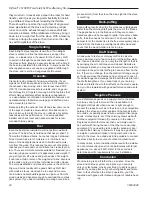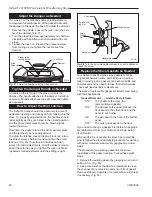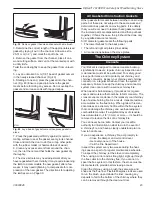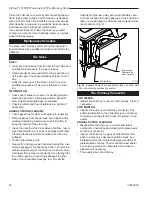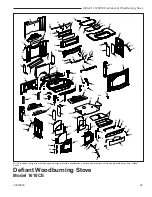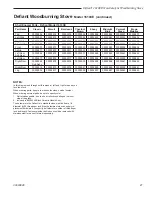
0
Defiant
®
1610CE Non-Catalytic Woodburning Stove
30003846
they must turn, it leaves some pipe in the room for heat
transfer, and it gives you long-term flexibility for install-
ing a different stove without relocating the thimble.
There should be no more than eight feet of single-wall
stove pipe between the stove and a chimney; longer
runs can cool the exhaust enough to cause draft and
creosote problems. With prefabricated chimney, bring it
down to six to eight feet from the stove. With a masonry
chimney, arrange the pipe so that it turns into the chim-
ney within eight feet of the stove.
Single venting
Each ‘airtight’ stove requires its own flue. If an airtight
stove is vented to a flue that also serves an open fire-
place, or a leakier stove, it’s easier for the chimney draft
to pull air in through those channels and performance of
the stove suffers. Imagine a vacuum cleaner with a hole in
the hose to understand the effect here. In some cases the
other appliance can even cause a negative draft through
the stove, and result in a dangerous draft reversal.
creosote
Creosote is a by-product of slow wood-burning. It’s an
organic tar that can condense in the flue if it is present in
the exhaust, slow-moving, and cools to less than 90°F
(130°C). Condensed creosote is volatile, and can gener-
ate chimney fires if it gets hot enough. All the features that
affect chimney draft also affect creosote condensation
- so use whatever combination of installation features and
operational steps that will encourage good draft and mini-
mize creosote production.
Because letting the exhaust cool off and slow down is one
of the keys to creosote accumulation, it makes sense to
line a chimney to match the stove’s outlet size, for safety
reasons as well as performance. Consult a qualified
installer and check local and national codes for recom-
mended chimney sizing.
Fuel
Even the best stove installation will not perform well with
poor fuel. The best fuel is hardwood that has air-dried 1-
18 months. Softwood burns, but not as long as hardwood.
‘Green’ wood has a lot of moisture in it; it will burn, but
some of the heat potential is used to boil the extra mois-
ture from the wood. This reduces the amount of heat that
reaches your home and can contribute to a creosote prob-
lem. There are moisture meters available for firewood; you
can also judge your wood by its appearance and weight. If
you get it green, lift a piece and get a sense of its weight;
it can lose a third or more of its weight as it dries. Also look
at the ends of a log; as it dries it shrinks and often cracks.
The more weathered and cracked a piece is, the drier it is.
Dry wood burns readily with a good chimney draft. But
with modern stoves, wood can be too dry and too vola-
tile. Smoke and combustible gases can ‘gas out’ from the
wood quickly and densely enough to overload the combus-
tion system. If you hear a rumbling or roaring noise (like a
propane torch) from the stove, that is a sign that the stove
is overfiring.
back-puffing
Back-puffing results when the fire produces volatile gases
faster than the chimney draft pulls them out of the firebox.
The gases back up in the firebox until they are concen-
trated enough and hot enough to ignite. If your stove back-
puffs, the stove needs to cool down. You should open the
damper to let the smoke rise to the flue more quickly, allow
more air into the firebox, avoid big loads of firewood and
check that the wood moisture is not too low.
Draft Testing
An easy way to test your chimney draft is to close the
stove’s damper, wait a few minutes to let the airflow stabi-
lize, then see whether you can vary the strength of the fire
by swinging the air control open and closed. Results are
not always instant; you may need to wait a few minutes for
a change in the air control setting to have an effect on the
fire. If there’s no change, then the draft isn’t strong enough
yet to let you close the damper, and you’ll need to open it
for awhile longer and manage the fire with the air inlet until
the draft strengthens. If you keep track of your burning
habits and relate them to their effects on the stove’s opera-
tion, you’ll be rewarded with good performance and a safe
system.
Negative pressure
Good draft also depends on a supply of air to the stove;
a chimney can’t pull in more air than is available to it.
Sluggish draft results when a house is tight enough to
prevent the ready flow of air to the stove, or by competition
between the stove and other equipment that sends indoor
air outside - especially power-driven equipment like range
hoods, clothes dryers, etc. If the chimney draws well with
all other equipment turned off (or sealed, in the case of
fireplaces and/or other stoves), then you simply need to
be careful with timing the use of the other air consuming
equipment. If you need to crack a nearby window or door
to enable the chimney to flow well, it may be a good idea
to install an outside-air intake to bring combustion air di-
rectly to the stove. An outside air kit is available to connect
the stove directly to a source of outdoor combustion air.
In many cases, local or national codes require the installa-
tion of permanently open air vents, particularly with larger
appliances (i.e. above 5 kW). Refer to these codes to
determine specific requirements for your installation.
conclusion
Wood-burning is an art rather than a science. Once the
stove and chimney system are in place, you can only
vary your technique, mostly your timing, to achieve good
results. If you keep track of your burning habits and relate
them to their effects on the stove’s operation, you’ll be
rewarded with good performance and year of reliable heat-
ing.















